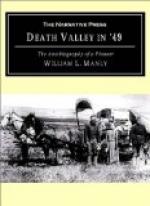Nothing special occurred during our passage till we were near the mouth of the Mississippi River, when, in the absence of a pilot boat or tug, our Captain thought he would try to get in alone, and as a consequence we were soon fast in the mud. The Captain now made all the passengers go aft, and worked the engine hard but could not move her at all. The tide was now low, and there was a prospect that we should have to wait full six hours to get away. We worked on, however, and after a few hours a tug came to our assistance and pulled us out of the mud and towed us into the right channel, up which we steamed on our way to New Orleans, one-hundred-twenty miles away.
The country on both sides of us was an immense marsh—no hills in sight, no timber, nothing but the same level marsh or prairie. When we were nearer the Crescent City some houses came in sight; then we passed General Jackson’s battle-field, and in due time reached the city.
On board this ship I became acquainted with Dick Evans who lived in the same county that I used to in Wisconsin, near Mineral Point, so the three of us now concluded to travel together.
New Orleans seemed to be a very large city. Near the levee a large government building was in course of construction for a Custom House. It was all of stone, and the walls were up about two stories. We put up at a private boarding house, and the first business was to try and sell our gold dust. So we went to the mint and were told we would have to wait ten days to run it through the mill, and we did not like to wait so long. We were shown all through the mint and saw all the wonders of coin making. Every thing seemed perfect here. Beautiful machinery was in operation making all sizes of gold coins, from a twenty dollar piece down. Strips of gold bands about six feet long and of the proper thickness for twenty dollar pieces are run through a machine which cuts out the pieces, and when these are cut they can stamp out the pieces as fast as one can count.
This was the most ingenious work I ever saw, and very wonderful and astonishing to a backwoodsman like myself, for I supposed that money was run in moulds like bullets.
As we could not wait we went to a bank and sold our dust, getting only sixteen dollars per ounce, the same price they paid in California. We now took the cars and rode out to Lake Ponchartrain—most of the way over a trestle work. We found a wharf and warehouse at the lake, and a steamer lay there all ready to go across to the other side. The country all about looked low, with no hills in sight.
When we returned to the city we looked all about, and in the course of our travels came to a slave market. Here there were all sorts of black folks for sale; big and little, old and young and all sorts. They all seemed good-natured, and were clean, and seemed to think they were worth a good deal of money. Looking at them a few minutes sent my mind back to St. Joseph, Missouri, where I saw a black sold at auction. From my standpoint of education I did not approve of this way of trading in colored people.




